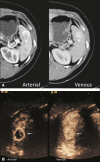Common and uncommon features of focal splenic lesions on contrast-enhanced ultrasound: a pictorial review
- PMID: 29307931
- PMCID: PMC5746885
- DOI: 10.1590/0100-3984.2015.0209
Common and uncommon features of focal splenic lesions on contrast-enhanced ultrasound: a pictorial review
Abstract
The characterization of focal splenic lesions by ultrasound can be quite challenging. The recent introduction of contrast-enhanced ultrasound (CEUS) has come to play a valuable role in the field of imaging splenic pathologies, offering the possibility of an ionizing radiation-free investigation. Because CEUS has been incorporated into everyday clinical practice, malignant diseases such as focal lymphomatous infiltration, metastatic deposits, benign cysts, traumatic fractures, and hemangiomas can now be accurately depicted and characterized without the need for further imaging. More specifically, splenic traumatic fractures do not require additional imaging by computed tomography (with ionizing radiation exposure) for follow-up, because splenic fractures and their complications are safely imaged with CEUS. In the new era of CEUS, more patients benefit from radiation-free investigation of splenic pathologies with high diagnostic accuracy.
A caracterização de lesões focais esplênicas pela ultrassonografia pode ser bastante desafiadora. A introdução da ultrassonografia com contraste por microbolhas vem ganhando papel importante no campo da avaliação por imagem das doenças esplênicas, oferecendo um método livre de radiação ionizante. Após a implementação da ultrassonografia contrastada na prática médica, doenças malignas como linfomas e metástases, bem como benignas, como cistos, lesões traumáticas e hemangiomas, podem ser observadas e caracterizadas de maneira acurada, sem a necessidade de prosseguir a investigação com outros métodos de imagem. Mais especificamente, lesões traumáticas esplênicas podem ser acompanhadas por meio da ultrassonografia contrastada, evitando a radiação ionizante da tomografia computadorizada, uma vez que as fraturas esplênicas e suas potenciais complicações são seguramente demonstradas por esse método ultrassonográfico. Na nova era do uso dos contrastes para ultrassonografia, mais pacientes serão beneficiados por investigações livres de radiação para avaliação de afecções do baço, com alta acurácia diagnóstica.
Keywords: Microbubbles; Neoplasms; Spleen/diagnostic imaging; Ultrasonography/methods; Wounds and injuries.
Figures















References
-
- Piscaglia F, Nolsoe C, Dietrich CF, et al. The EFSUMB guidelines and recommendations on the clinical practice of contrast enhanced ultrasound (CEUS): update 2011 on non-hepatic applications. Ultraschall Med. 2012;33:33–59. - PubMed
-
- Claudon M, Dietrich CF, Choi BI, et al. Guidelines and good clinical practice recommendations for contrast enhanced ultrasound (CEUS) in the liver - update 2012: a WFUMB-EFSUMB initiative in cooperation with representatives of AFSUMB, AIUM, ASUM, FLAUS and ICUS. Ultrasound Med Biol. 2013;39:187–210. - PubMed
-
- Wilson SR, Burns PN. Microbubble-enhanced US in body imaging: what role? Radiology. 2010;257:24–39. - PubMed
-
- Catalano O, Aiani L, Barozzi L, et al. CEUS in abdominal trauma: multi-center study. Abdom Imaging. 2009;34:225–234. - PubMed
-
- Peddu P, Shah M, Sidhu PS. Splenic abnormalities: a comparative review of ultrasound, microbubble-enhanced ultrasound and computed tomography. Clin Radiol. 2004;59:777–792. - PubMed
LinkOut - more resources
Full Text Sources
Other Literature Sources
